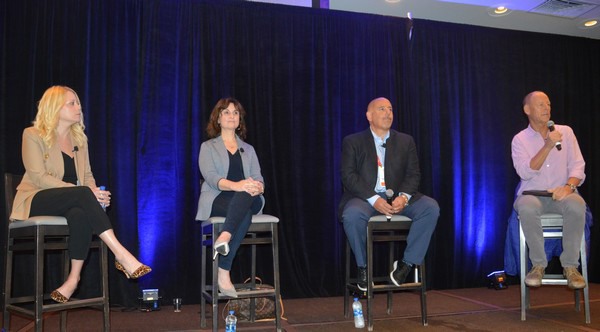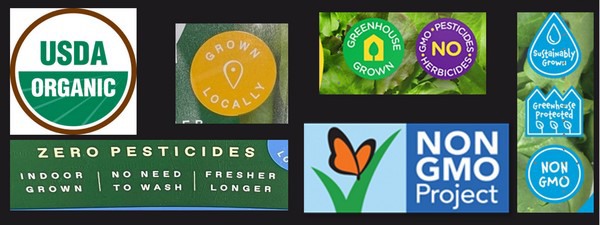How do retailers market indoor-grown produce? Does the consumer know the difference between produce that’s grown indoors versus outdoors? If so, does the consumer care? This article summarizes a panel discussion on the Growth of Controlled Environment Agriculture from a retailer/consumer perspective that took place at last week’s Organic Produce Summit. It follows a discussion on the growth of CEA from a producer’s perspective.
Moderated by Walter Robb, former co-CEO of Whole Foods Market, three panelists talked about CEA from a retailer/consumer perspective. Although all panelists had different insights to bring to the table, they agreed that CEA will support growth in the produce industry, but it’s important to educate the customer on the CEA story. Victor Savanello with SpartanNash, a grocery distributor and retailer in the Midwest, commented how CEA introduces a level of excitement that hasn’t been seen in a while. “We just need to find a way to tell the story to the customer.”
When asked if CEA is a hype or reality, Frances Dillard, with Driscoll’s suggested not to think of the word ‘hype’ as something negative but as something good. “Let’s embrace the disruption, let’s embrace CEA and figure out how to grow our industry,” she said. Caitlin Tierney with Sprouts Farmers Market also believes CEA is a reality. “It is just an accent to agriculture, and the more we can control the environment, the better,” she said.
 From left to right: panelists Caitlin Tierney, Frances Dillard, Victor Savanello, and moderator Walter Robb.
From left to right: panelists Caitlin Tierney, Frances Dillard, Victor Savanello, and moderator Walter Robb.
Is CEA important to the consumer?
What do consumers think of CEA? “I am pretty sure they don’t know anything about it,” says Driscoll’s Dillard. “They are still buying based on flavor and aspects of freshness. These are the two key purchase drivers.” Savanello agrees that it probably doesn’t matter to the consumer whether the products are grown indoors or outdoors. “However, as an industry, we need to make sure the consumer knows how to identify it. For instance, the indoor tomato snacking category has created flavors that are beyond belief, and the indoor industry overall has a great story. However, the consumer doesn’t know where these tomatoes come from, and we don’t do a good job telling them.”
Although the consumer may not know what CEA is, the segment has the potential to play a key role in the access to food. “I am worried about the supply chain,” said Savanello. Logistics have made it challenging to keep the produce aisle stocked. “Being able to find a closer supplier is very important and something we look at,” he said. “It would enable us to get the product faster and allow for more consistency.”
For that very reason, Tierney believes CEA-grown produce will become increasingly important. “If we are able to grow produce closer to the consumer and take travel miles off, we will provide a fresher, higher quality product, which supports consumption increase. CEA has the ability to do that.”
How do we get the consumer to eat more produce?
Dillard already mentioned how flavor and freshness are key purchase drivers. “We need to continue developing products with excellent flavor. Premiumization shows consumers are willing to pay more for a unique, high-flavor product.” As an example, she mentioned how Driscoll’s partnership with Plenty is expected to bring just that. “I see an opportunity for growth in upgrading from the items we are familiar with,” said Savanello. Tierney suggested to take a look at Europe. “Europe has always been seven to ten years ahead of us in variety development, packaging, etc.”
 Examples of different labels. Photo: Organic Produce Network.
Examples of different labels. Photo: Organic Produce Network.
Is the variety of labels confusing?
When walking the produce aisle, the variety of labels used on produce items can be quite overwhelming. They vary from organic to non-GMO, pesticide-free, locally grown, indoor-grown, and greenhouse-grown. Is that confusing to the consumer? Savanello feels consistency in labeling is important, but whether it is organic or not is not equally important in all segments of the fresh produce industry. “In the berry sector, it’s all about flavor, whereas an organic label is very important in leafy greens.”
To Tierney, it is all about caring. “If a grower is able to connect the consumer’s heart with their product, sales will increase. Caring is local to me,” she added. She went on to say how she struggles with CEA-grown produce not being organic if hydroponic growing techniques are being used. “CEA really needs a stamp. It’s pesticide-free and grown the best way possible. It’s close by the best flavor.”
